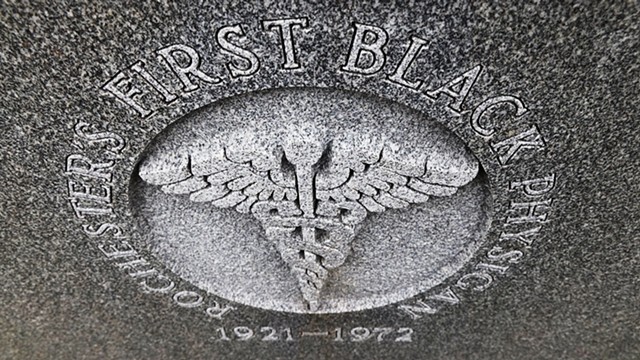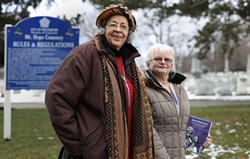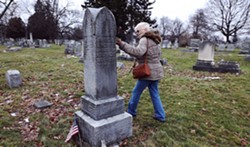On a winter morning, it is peaceful at Mt. Hope Cemetery. A blanket of snow covers the ground. A few people walk dogs. The only noise is the sound of the snow crunching under foot.
Thousands of years ago, glaciers carved the lofty ridges and bucolic valleys that cut through the 196 acres of the cemetery, much like the lives of the people buried in its hilly landscape shaped the city’s history.
"There are over 300,000 people here and I tell people there are 300,000 stories," Marilyn Nolte, of the Friends of Mt. Hope Cemetery, said on a tour of the grounds. "Look at the gravestone that says 'gone and not forgotten,' but the truth is, it's 'gone and soon forgotten' for most people, and that's sad."
Nolte has unearthed some of those forgotten stories in “Beyond These Gates: Mountains of Hope in Rochester’s African-American History,” a book she co-authored with Verdis Robinson, a scholar of African-American history.
The book seeks to ensure that black Rochester residents who escaped slavery, fought in wars, and broke down barriers, are not simply remembered, but serve as an inspiration.
 There was Charles Lunsford, for instance. He was Rochester's first licensed African-American physician, having started his medical practice here on Clarissa Street in 1921.
There was Charles Lunsford, for instance. He was Rochester's first licensed African-American physician, having started his medical practice here on Clarissa Street in 1921.
"He had graduated first, top in his medical school from Howard University, but here, they blocked him from being able to practice medicine with his patients in the hospital," said Carolyne Blount, who researched many of the stories featured in the book.
But Lunsford persisted in the face of discrimination. He is widely credited with overturning the nationwide American Red Cross’s racist policy prohibiting black people from donating blood, by recruiting a group of light-skinned African-Americans who passed for white, to make donations.
Lunsford then reported his stunt to the Democrat and Chronicle, which forwarded Lunsford’s letter to the organization’s headquarters in Washington, D.C. Within days, Red Cross officials turned up in Rochester and announced a policy change allowing black people to give blood.
"The doctors and professionals like that and the clergy people, they were self-employed, so you didn't have that fear of, 'Oh, I might get fired from my job if I speak up.' That's what gave them the freedom to be the activists that they were," Blount explained.
Mt. Hope is the final resting place of many African American pioneers. 
Thomas Boyde was Rochester's first black architect. His works can still be spotted across the city and its suburbs. He helped design the Strathallan Hotel, the Rundel Public Library, and Monroe Community Hospital.
Among his contributions to the hospital were gargoyles poised on the exterior, a feature that exists to this day and for which he was denied credit for nearly 60 years.
Many of those interred at Mt. Hope earned their living in more humble ways, but their stories are no less compelling.
Striving for racial equality was the focus of Jacob Morris's life. He was born a free man in 1808 and helped fugitive slaves escape to freedom in Canada through the Underground Railroad. By day, Morris worked as a barber at a Rochester hotel. His wealthy, white clients unwittingly gave him valuable information.
"He could hear the gossip as to where the slave owners were, who was coming to town," Blount said.
Decades later, in 1903, Solomon Young made a name for himself when he relocated to Rochester from North Carolina. He lived at a prestigious address — 900 East Avenue — where he was employed as George Eastman’s butler and valet.
Young is believed to be the first African American in Rochester to own a car.
"Yeah, it was a convertible," Blount laughed.
About 30 years after he started working for the founder of Eastman Kodak, Young became inextricably linked to the city’s history in a tragic way when, in 1932, he discovered the body of George Eastman after he had taken his life in his mansion.
Mt. Hope, of course, is the final resting place of several iconic figures, including Frederick Douglass and Susan B. Anthony.
One family in Rochester today traces its roots to another of the most historic figures buried at Mt. Hope in Nathan Sprague, the husband of Rosetta Douglass, the daughter of Frederick.

Jacqueline Sprague Cooper and Katherine Sprague Dexter are great-great nieces to Sprague. Katherine said she and her sister heard about the family history since their childhood, but didn't grasp the significance of it until they were older.
"Then it started hitting us, I mean, almost like a slap in the face," she said. "Do you realize the significance of it?"
Like Douglass, Nathan and Rosetta Sprague were committed to social justice. Jacqueline said if she could talk today to her great-great uncle Nathan, she would thank him for his strength and dignity.
"It's carried on through the generations,” she said.
The Spragues are empowered by their family’s history. It has inspired their relatives’ forays into the fields of law enforcement, real estate, medicine, and education. They remain committed to the family’s centuries old values of social service and advocacy through volunteer work.
Learning through legacy is what Nolte and Blount hope the book teaches.
"I think that reading history and knowing what your forefathers and others have contributed...if you have that within you," Blount said, "I think it gives you courage to go forward and make changes yourself that are positive."
If the Mt. Hope Cemetery stories have one enduring message, it may be to simply carry on.
Beth Adams is a reporter at WXXI, a media partner of CITY. She can be reached at [email protected].
Thousands of years ago, glaciers carved the lofty ridges and bucolic valleys that cut through the 196 acres of the cemetery, much like the lives of the people buried in its hilly landscape shaped the city’s history.
"There are over 300,000 people here and I tell people there are 300,000 stories," Marilyn Nolte, of the Friends of Mt. Hope Cemetery, said on a tour of the grounds. "Look at the gravestone that says 'gone and not forgotten,' but the truth is, it's 'gone and soon forgotten' for most people, and that's sad."
Nolte has unearthed some of those forgotten stories in “Beyond These Gates: Mountains of Hope in Rochester’s African-American History,” a book she co-authored with Verdis Robinson, a scholar of African-American history.
The book seeks to ensure that black Rochester residents who escaped slavery, fought in wars, and broke down barriers, are not simply remembered, but serve as an inspiration.

- PHOTO BY MAX SCHULTE
- The gravestone of Charles Lunsford, Rochester's first licensed African-American physician. Lunsford is credited with getting the American Red Cross to overturn a racist policy that prohibited black people from donating blood.
"He had graduated first, top in his medical school from Howard University, but here, they blocked him from being able to practice medicine with his patients in the hospital," said Carolyne Blount, who researched many of the stories featured in the book.
But Lunsford persisted in the face of discrimination. He is widely credited with overturning the nationwide American Red Cross’s racist policy prohibiting black people from donating blood, by recruiting a group of light-skinned African-Americans who passed for white, to make donations.
Lunsford then reported his stunt to the Democrat and Chronicle, which forwarded Lunsford’s letter to the organization’s headquarters in Washington, D.C. Within days, Red Cross officials turned up in Rochester and announced a policy change allowing black people to give blood.
"The doctors and professionals like that and the clergy people, they were self-employed, so you didn't have that fear of, 'Oh, I might get fired from my job if I speak up.' That's what gave them the freedom to be the activists that they were," Blount explained.
Mt. Hope is the final resting place of many African American pioneers.

- PHOTO BY MAX SCHULTE
- Carolyne Blount, left, researched many of the stories featured in “Beyond These Gates: Mountains of Hope in Rochester’s African-American History,” a book Marilyn Nolte, right, co-authored with African-American history scholar Verdis Robinson.
Thomas Boyde was Rochester's first black architect. His works can still be spotted across the city and its suburbs. He helped design the Strathallan Hotel, the Rundel Public Library, and Monroe Community Hospital.
Among his contributions to the hospital were gargoyles poised on the exterior, a feature that exists to this day and for which he was denied credit for nearly 60 years.
Many of those interred at Mt. Hope earned their living in more humble ways, but their stories are no less compelling.
Striving for racial equality was the focus of Jacob Morris's life. He was born a free man in 1808 and helped fugitive slaves escape to freedom in Canada through the Underground Railroad. By day, Morris worked as a barber at a Rochester hotel. His wealthy, white clients unwittingly gave him valuable information.
"He could hear the gossip as to where the slave owners were, who was coming to town," Blount said.
Decades later, in 1903, Solomon Young made a name for himself when he relocated to Rochester from North Carolina. He lived at a prestigious address — 900 East Avenue — where he was employed as George Eastman’s butler and valet.
Young is believed to be the first African American in Rochester to own a car.
"Yeah, it was a convertible," Blount laughed.
About 30 years after he started working for the founder of Eastman Kodak, Young became inextricably linked to the city’s history in a tragic way when, in 1932, he discovered the body of George Eastman after he had taken his life in his mansion.
Mt. Hope, of course, is the final resting place of several iconic figures, including Frederick Douglass and Susan B. Anthony.
One family in Rochester today traces its roots to another of the most historic figures buried at Mt. Hope in Nathan Sprague, the husband of Rosetta Douglass, the daughter of Frederick.

- PHOTO BY MAX SCHULTE
- Marilyn Nolte, of the Friends of Mt. Hope Cemetery, visits the Sprague family plot.
Jacqueline Sprague Cooper and Katherine Sprague Dexter are great-great nieces to Sprague. Katherine said she and her sister heard about the family history since their childhood, but didn't grasp the significance of it until they were older.
"Then it started hitting us, I mean, almost like a slap in the face," she said. "Do you realize the significance of it?"
Like Douglass, Nathan and Rosetta Sprague were committed to social justice. Jacqueline said if she could talk today to her great-great uncle Nathan, she would thank him for his strength and dignity.
"It's carried on through the generations,” she said.
The Spragues are empowered by their family’s history. It has inspired their relatives’ forays into the fields of law enforcement, real estate, medicine, and education. They remain committed to the family’s centuries old values of social service and advocacy through volunteer work.
Learning through legacy is what Nolte and Blount hope the book teaches.
"I think that reading history and knowing what your forefathers and others have contributed...if you have that within you," Blount said, "I think it gives you courage to go forward and make changes yourself that are positive."
If the Mt. Hope Cemetery stories have one enduring message, it may be to simply carry on.
Beth Adams is a reporter at WXXI, a media partner of CITY. She can be reached at [email protected].
